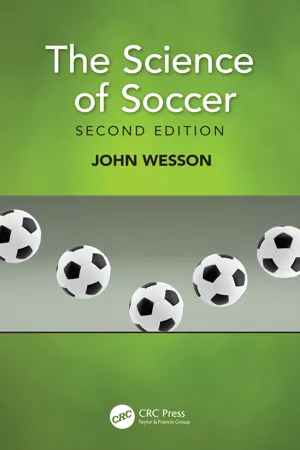Physics
Bouncing Ball Example
The bouncing ball example illustrates the principles of conservation of energy and momentum. When a ball is dropped, it initially has gravitational potential energy, which is converted to kinetic energy as it falls. Upon hitting the ground, the ball's kinetic energy is transferred to the ground, causing it to bounce back up. This demonstrates the conversion and transfer of energy in a simple yet fundamental way.
Written by Perlego with AI-assistance
5 Key excerpts on "Bouncing Ball Example"
Learn about this page
Index pages curate the most relevant extracts from our library of academic textbooks. They’ve been created using an in-house natural language model (NLM), each adding context and meaning to key research topics.
- eBook - ePub
The Really Useful Book of Science Experiments
100 easy ideas for primary school teachers
- Tracy-ann Aston(Author)
- 2015(Publication Date)
- Routledge(Publisher)
Experiment 60Bouncy balls!Learning Objectives:
Investigating how bouncy different balls are.Introduction:
The children investigate how well different balls bounce by looking at how many times they bounce when dropped from a set height.Useful Prior Work:
The children should know that objects fall to the Earth because of gravity.Background Science:
When an object is dropped, it will fall towards the Earth because of the effect of gravity. Gravity acts equally on all objects, so heavier objects do not fall faster than lighter objects. When an object that is dropped comes into contact with a surface, such as the ground, it will experience a contact force. This force may stop the object moving altogether. However, if the object can be compressed slightly, the force will push the particles of the object closer together, converting some of its kinetic (movement) energy into potential energy (stored energy). This potential energy is what allows the object to ‘bounce’, as the particles that were squashed together now begin to move apart again. This is why objects that are elastic are more likely to bounce than solid objects. The more elastic the object is, the more it will be compressed when it first comes into contact with the surface, therefore the more potential energy will be stored in the object and the higher it will bounce, resulting in further potential energy being stored when it next hits the surface, resulting in more bounces overall. - eBook - ePub
Essential Effects
Water, Fire, Wind, and More
- Mauro Maressa(Author)
- 2018(Publication Date)
- CRC Press(Publisher)
CHAPTER 21 Bouncing BallOur greatest glory is not in never falling, but in rising every time we fall. —ConfuciusA great way to learn and practice timing is the bouncing ball routine. We will use several different objects in this exercise. How do I approach animating these objects? I need to consider the mass of each object, and the flexibility of its shell, its texture, and composition will also give me some insight. But my best reflection and study will be the fact that I’ve already seen these objects in action and witnessed them over my lifetime and know how these objects have reacted. So I have experience stored in my memories. I just need to recall what I already know and use these memories plus a little imagination and caricaturization to help me animate them.Let’s think about the science of it first! The energy of motion, or kinetic energy, the energy an object builds up as it’s falling from a table, deforms the object (squash) and converts it to potential energy when it hits the floor. That potential energy now gives the object its ability to bounce back up. This potential energy, or stored-up energy, as it is squashing enables the object to now transfer or release that energy to return to its original shape by discharging it (stretch). The amount of “bounce” an object has depends on its composition: hardness, surface texture, size, its core makeup, and so on. These are all mental exercises I would like you to ponder as you work out the possibilities.A beach ball is very light, with hardly any weight or mass associated with it. It therefore can’t build up a lot of energy as it falls. Its shell is very flexible and it doesn’t have a core density, other than the fact that it’s full of air. So unless propelled by someone hitting it, it won’t bounce very much. The timing charts will show us how fast it slows down during its squash and springs upward in the recoil and where it will slow down at the apex of its arc as it bounces up and down. In this example, it takes the beach ball seven frames to roll off the table and touch the ground. From Frames 1 to 6, the ball builds energy by moving faster. Note the spacing on the timing chart. On Frame 7, it touches the ground but doesn’t squash yet (see Figure 21.1 - eBook - ePub
Biomechanics of Human Motion
Applications in the Martial Arts, Second Edition
- Emeric Arus, Ph.D.(Authors)
- 2017(Publication Date)
- CRC Press(Publisher)
In this case, we speak about elasticity of the object(s). A collision in which the total kinetic energy after the collision is less than that before the collision is called an inelastic collision. To be more explicit, the body or bodies will change their physical shape. Example includes a car crash or when two bodies stick together after the collision, for example, a sticky material thrown against the wall. A collision in which the total kinetic energy of a system will remain the same after the collision is called elastic collision. To be more explicit, the bodies will deflect each other with no physical change of shape. An example is when two billiard balls collide. The body has the tendency to return to its normal shape once it has been deformed, that is, its elasticity differs from one body to another. Some return very quickly to their original shape, while others do so less quickly. Because there is no way of directly calculating the elasticity of a body, it is necessary to rely on the different experiment results to predict the outcome of any given impact. Newton formulated an empirical law, Newton’s law of impact, which states that if two bodies move toward one another along the same straight line, the difference between their velocities before the impact is proportional to the difference between their velocities after the impact. In order to correctly calculate the velocities before and after the impact, there is a term coefficient of restitution, which must be used in our calculation. The coefficient of restitution (e) or COR is an indicator of elasticity of an object reflecting the ability of the object to return to its original shape once deformed, measured by the ratio of the impulse of rebound to the impulse of impact. This coefficient has a value between “1” and “0.” The value of “1” indicates an elastic collision. The value toward “0” indicates an inelastic collision - Paul Grimshaw, Neil Fowler, Adrian Lees, Adrian Burden(Authors)
- 2007(Publication Date)
- Routledge(Publisher)
Fig. B4.1 illustrates some other examples of collisions with human movement.Consider Newton’s first law of motion, the law of inertia where a body will remain in a state of rest or constant velocity unless it is acted upon by an external force. We can now extend this law for examples involving collisions to explain the principle of conservation of linear momentum.Principle of conservation of linear momentum
The principle of conservation of linear momentum states that in any system where bodies collide (and there can be more than two bodies) or exert a force upon each other, the total momentum in any direction remains constant unless some external force acts on the system in that direction. In this context the term system can be used to describe two or more bodies in motion that exert forces on each other.Fig. B4.2illustrates this in the catching of a ball during goalkeeping in soccer (the goalkeeper is shown catching the ball in the air because of the external forces that would need to be considered if the goalkeeper was on the ground).As we can see fromFig. B4.2, the momentum of the ball and the goalkeeper (the system) before the collision (the catching of the ball) is equal to the momentum of the system (the ball and the goalkeeper together) after the collision (the catch). For simplicity the ball and the goalkeeper before contact could be termed system-1 and the ball and goalkeeper together after contact (when the goalkeeper holds the ball) termed system-2.Fig. B4.1. Collisions between bodies within human movementFig. B4.2. A system of forces before and after collision: goalkeeper catching a ball in soccer (in the air)- eBook - ePub
- John Wesson(Author)
- 2019(Publication Date)
- CRC Press(Publisher)
e , which is determined by the change of speed for a ball impacting a surface at a right angle. The definition ise =.speed after impactspeed before impactBecause of the dependence on the playing surface this coefficient is quite variable, but on a good pitch it is typically around 0.5. The effect of the change of speed can be seen from the height of successive bounces. The height, h , of a bounce is found by equating the kinetic energywhen leaving the ground to the potential energy mhg when the ball reaches the top of its bounce, g being the gravitational acceleration. Thusm1 2υ 2h =.υ 22 gIf the ball now falls back to the ground it will again have a speed ʋ on reaching the ground, but on leaving the ground after its second bounce it will have a velocity eʋ , and will now only bounce to a height h 2 given byh 2==( e υ )22 ge 2h .We see therefore that for e = 0.5 successive bounces are reduced tothe height of the previous bounce. Players generally find this to be satisfactory. When plastic pitches were introduced into professional football for a while, they sometimes produced too high a bounce, making it more difficult to play a controlled game.1 41.3. Angular momentumBounces usually involve spin and to investigate the role of spin it is necessary to introduce the concept of angular momentum. We shall take a brief diversion to look at this and to illustrate the basic elements involved in rotational motion.Figure 10.2. Pivoted rod.For rotation about a fixed axis it is convenient to express Newton’s second law in a form which gives the change of rotation in terms of the applied force. In this form the equations say that the rate of change of the angular momentum is equal to the applied torque. To understand these concepts, consider the simple example of a thin rod pivoted about one end, with a perpendicular force applied to the other, as illustrated in figure 10.2 . For simplicity we shall assume there is no gravitational force. Let the rod have a varying mass distribution along its length, giving it a density ρ




